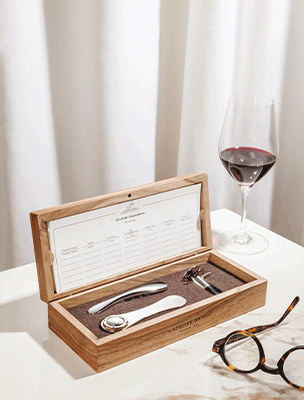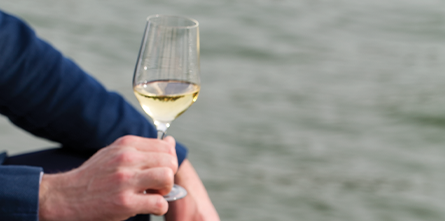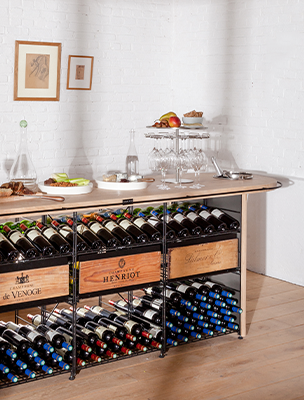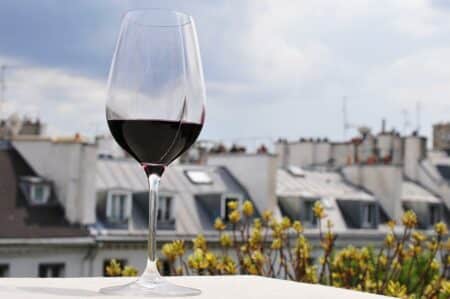
Of all the sommelier tools and oenological accessories, wine glasses hold a particularly special place. Indeed, the so-called “nectar of the gods” would never reach your palate without this crystalline cup, the sole vessel that can make the wine dance, reveal its true colours, and allow it to fully express itself. To honour your vintage wines, a tasting glass must therefore be selected with great care. But what makes a glass a true wine glass? What aspects should you take into account when choosing? This wine glass guide will assist you in your oenological glassware choices and shed light on the use of these sacred chalices.
Definition and Characteristics of a Wine Glass
A wine glass is a crystalline receptacle, specially designed for tasting the nectar of the vineyards. Recognisable by its calyx, stem and base, its unique ergonomics were above all designed to create the best possible tasting conditions, whether at the dinner table, in a wine cellar, or on a vineyard. The shape, height and capacity of a wine glass may vary depending on whether a white, red, rosé or sparkling wine is to be served, as well as different regional traditions. Manufacturing norms and standards were therefore defined to create a common reference, known as the AFNOR or INAO wine glass, particularly important for wine tasting competitions or valuations.
The Components of a Wine Glass
When designing a wine glass, nothing is left to chance. Each component that makes up this wine tool has a name and a specific function, in order to offer the best possible tasting experience.
Here are the main parts that constitute a wine glass:
- the calyx, or bowl: the body of the glass, usually oval
- the stem or leg: lower vertical part that supports the calyx
- the button: reinforced part of the upper stem that supports the calyx
- the foot or the base: round horizontal part on which the stem rests
To avoid any confusion, it is also worth noting the terms that define certain parts or attributes of the glass’ calyx:
- the paraison: rounded part of the calyx that holds the wine
- the shoulder: broadest part of the glass located in the middle of the calyx
- the chimney: upper part of the calyx that is usually narrower towards the top
- the rim: upper circle of the calyx that touches your lips when tasting the wine
The Different Types of Wine Glasses
A wine may express itself differently depending on the tasting glass in which it is served. For example, a red wine glass is a slightly different shape than a white wine glass, while a sparkling wine glass or champagne flute is very different.
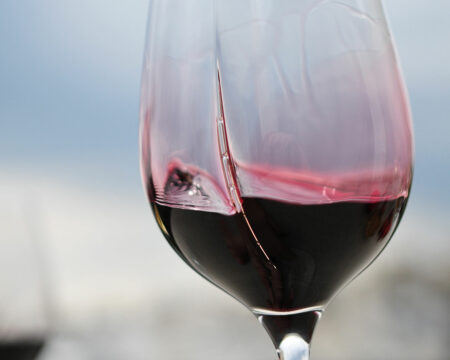
The Red Wine Glass
The calyx on a red wine glass is larger and deeper than that of a white wine glass. This can be explained by the fact that a red vintage requires more room to fully express itself, in order to release its aromas and unfold its flavours at room temperature.
The White Wine Glass
White wine glasses are characterised by a smaller bowl, which keeps the wine fresh during tasting and ensures that the balance of aromas is not lost.
The Champagne Flute and Sparkling Wine Glass
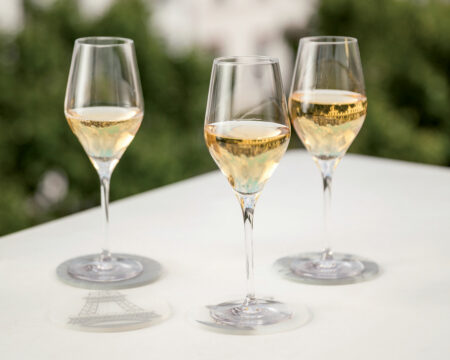
Sparkling wine glasses have a slimmer, more slender shape, to prolong the effervescence and explosion of bubbles in the mouth. They are more commonly referred to as champagne glasses or flutes.
A Few Tips to Choose the Right Wine Glass
Choosing your wine glass is an important decision, because the transition from a bottle or decanter into your glass in the final step of wine tasting. Which model of wine glass should you choose? Which glasses should be included in any wine cellar or kitchen cupboard? Here are some practical sommellerie and oenology tips.
The Aesthetics of a Wine Glass
Transparency, simplicity, humility and finesse are all noble virtues for a wine tasting glass, which should aim to showcase vintages and allow them to fully express themselves. Forget about coloured or patterned glasses with fancy shapes… The aesthetics of a wine glass should serve the taste, by embracing optimal curves and proportions to release the aromas and enhance the taster’s olfactory and gustatory experience.
Regional Variations of Wine Glasses
In each region, a typical local wine glass shape has taken form over the centuries, and not without reason. Each area has its own winegrowing and winemaking traditions, as well as glassmaking, that reflect the specific characteristics of local vineyards and grape varieties. As such, traditional Bordeaux wine glasses are much slimmer and longer than the wider, more enveloping Burgundy ones. Alsatian wine glasses are also very different, with a high leg and small bowl, carefully decorated with the know-how of Alsatian expert glassmakers.
Which Wine Glasses to Choose
Which wine glasses should you have at home? Which model should you have in your wine cellar, or at hand for a wine tasting session? It is best to differentiate between your everyday glassware, and your special occasion or wine tasting glasses.
- At home, you should have a set of red wine glasses and white wine glasses that roughly match AFNOR standards in terms of size, in order to suit all types of grape varieties and AOC vineyards.
- If you have a space for wine tasting or a wine cellar with storage for your glassware and wine tools, we also recommend a separate set of wine tasting glasses, such as our signature glass, L’Exploreur Œnologie
- You may also wish to add a few regional wine glasses to your collection, to taste specific grands crus or wines from your favourite vineyards. This will enable you to appreciate the same vintage in different ways, depending on whether you sample it from a oenological wine tasting glass or a traditional regional wine glass.
How to Use a Wine Tasting Glass

Wine glasses only come into their own when used properly, down to the very last detail, with the right accessories. Every gesture counts. How far should you pour the wine? How should you hold a wine tasting glass? How should you drink from your crystalline glass? How should you clean and maintain your wine glasses? Below are some insights on how to use your tasting glasses properly and enjoy the content of your precious bottles all the more.
How to Pour Wine into a Tasting Glass
You should pour wine up to a quarter of the calyx, and never more than a third, to give the wine all the room it requires to express itself. You should use the right wine tools and accessories to ensure that the wine is not disturbed in any way between the moment you open the bottle and pour it into the bowl.
- A sommelier or oenologist corkscrew, as well as a pourer to be positioned on the neck of the bottle, so as to open it properly and serve with precision, without any drops or spills.
- If the wine needs to be decanted to avoid any deposit in the glass, use a wine decanter.
- To aerate a young wine, use the Developer Universel, our aerator for wine glasses and decanters, which is placed on the rim. Its elegant shape gently exposes the wine to the air for longer.
- Finally, for a wine tasting session, or an evening with friends and family, our colourful wine glass brand, Chic Glass Rainbow, will ensure that your glasses don’t get mixed up, while adding a decorative touch to your table.
How to Hold your Wine Tasting Glass
You should hold the glass by its stem, and not the paraison, as you would a water tumbler. This ensures that the heat of your hands does not alter the temperature of the wine. It also avoids the taster’s fingers hiding the wine while they swirl it in the glass.
How to Drink from a Wine Tasting Glass
Drinking a good wine in a tasting glass is an art. Once the wine has been served, with the suitable accessories, swirl it around in your crystal bowl, holding the glass by the stem in gentle round movements. This will also enable you to appreciate the tears of wine on the paraison and to admire the colours in the light.
Before tasting, take the time to smell and breathe in your vintage wine, to appreciate its flavours and aromas as they release into the air and up to your nose. You can then gently place your lips on the rim and welcome the precious nectar to your palate. Once again, take your time and enjoy each sip. Swish the wine around in your mouth and aerate it, to experience each wine from beginning to end.
How to Clean and Maintain a Wine Glass
It goes without saying that a wine glass should always be clean and dry when serving, with no dust, soap residue, or anything that might hamper the enjoyment of a fine wine. To avoid scratching your glassware, it is best to wash it with micro-washing beads, rather than a sponge. Also remember to rinse it well, preferably with good quality water that is not too hard.
Once the glass has been cleaned, it should be dried with a microfibre polishing cloth, such as our Cristal Cleaner. This thick cloth was specially designed to wipe glassware and crystal, and is ideal for removing any drops, streaks or finger marks, as well as any residue that could alter the taste of your wine.
Finally, we recommend storing your wine glasses in a stable location:
- upright in a closed shelf,
- or upside down and hanging in a glass rack,
- but never rim-side down, so as to not damage this delicate part of the glass.
Our Collection of Wine Tasting Glasses
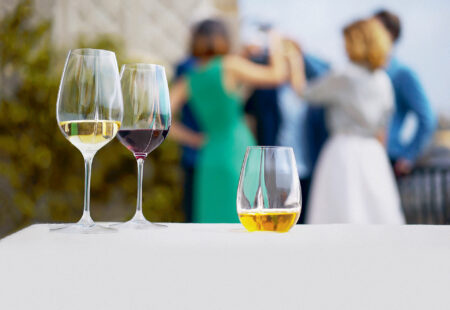
Since 1926, L’Atelier du Vin has been creating wine tools and accessories to offer you an authentic wine tasting experience, from the cellar to the dinner table. Discover our collection of wine glasses and share the art of living wine from generation to generation.
L’Exploreur Œnologie, our Wine Tasting Glass
This wine tasting glass, a little gem of glassware, is doted with a delicious Aroma Line, invented in France and patented worldwide. This beautiful beaded line runs from the paraison to the shoulder, enabling L’Exploreur Œnologie to release the aromas and stimulate your senses as the wine moves against the wall. A unique tasting experience.
Discover also L’Exploreur Spiritueux, our tasting glass that enhances your brown spirits, doted with our signature aroma line. Connoisseurs will appreciate its large volume and narrow opening, for maximum olfactory and gustatory pleasure.
Has this wine glass guide answered all your questions? To find out more, feel free to explore other guides to wine tools and the wine cellar.


